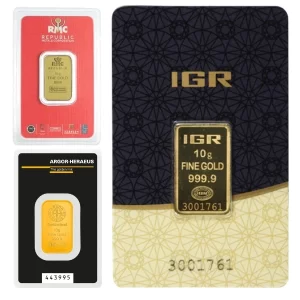It is almost becoming repetitive to continuously write about the uncertainty that plagues our current financial system, however, the times we find ourselves in are truly unprecedented and the slow unravelling of trillions of dollars in debt is going largely unnoticed. From the European Central Bank’s (ECB) alarming warning about gold’s potential to spark a financial crisis to China’s surging gold imports and the United States’ recent bond auction flop, the markets are sending unmistakable signals. In this week’s newsletter we will unpack these recent events and explore further why gold remains a cornerstone for wealth preservation in turbulent times.
The ECB’s Warning: Gold as a Safe Haven in a Fragile System
The European Central Bank recently sounded an alarm that has reverberated through financial circles: gold, the timeless safe-haven asset, could it potentially trigger the next financial crisis? According to the ECB’s Financial Stability Review, the surge in demand for physical gold, coupled with slowed delivery times, poses risks to the eurozone’s financial stability. The report highlights its concerns about overleveraged bets, opaque transactions, and the dominance of large traders, which could lead to liquidity stress and propagate shocks across the broader financial system if gone unchecked. Margin calls and the unwinding of these leveraged positions, particularly in physically settled gold derivatives (paper trades on gold that are paid out with physical gold), could exacerbate market instability during geopolitical stress; a time when securing gold is of the utmost priority.
Far from being a reason to shy away from gold, this warning underscores its critical role as a hedge against systemic fragility. The ECB’s concern reveals a deeper truth: gold’s rising demand is a symptom of a financial system under strain. As Frank Holmes, CEO of U.S. Global Investors, aptly stated, “Gold is a barometer of systemic fragility within the global financial system.” When central banks express fear over gold’s influence, it’s not because gold itself is inherently risky—it’s because it exposes the vulnerabilities of fiat currencies and centralized monetary policies. Investors are flocking to gold precisely because it is a decentralized, tangible asset with no counterparty risk, offering protection against continued currency devaluation and increased market volatility.
The ECB’s warning about slowed delivery times for bullion further highlights gold’s allure. As demand for physical gold surges, supply chain bottlenecks—such as those seen earlier this year with logjams at the Bank of England’s vaults—signal that investors are prioritizing physical ownership over digital paper gold that is owned a hundred times over. This rush to secure physical bullion is a proactive move to safeguard wealth ahead of potential crises, whether triggered by geopolitical tensions, inflation, financial system breakdowns or a combination of factors. Rather than deterring investment, the ECB’s caution should be a clarion call: owning physical gold now positions you to weather the storm that central banks themselves fear is brewing.
China’s Gold Rush: Imports Hit an 11-Month High
As the world’s largest gold producer and importer, China is at the forefront of the global gold rush. Recent data shows that China’s gold imports soared to an 11-month high last month (April, 2025), with 127.5 metric tonnes imported despite rising prices. This move represents a whopping 73% increase from March. This golden surge is driven by a combination of factors: a depreciating yuan, a shaky real estate market, and a broader push by the People’s Bank of China (PBOC) to diversify reserves away from the U.S. dollar.
China’s aggressive gold buying is not merely a market trend; it’s a strategic move to bolster economic credibility. As Holmes noted, “Everyone’s accumulating gold to create credibility for their paper money.” This trend extends beyond China, with central banks worldwide purchasing gold at a pace not seen since the 1960s, underscoring its role in stabilizing sovereign creditworthiness.
U.S. Bond Auction Flop and Surging Bond Yields: A Global Warning
The United States’ recent bond auction flop has sent ripples through global markets, amplifying concerns about a potential financial crisis triggered in world bond markets. The weak demand for U.S. Treasury bonds, coupled with surging bond yields worldwide, reflects growing investor skepticism about the sustainability of government debt. Reminder, current world debt sits around $325 TRILLION USD… An incomprehensible amount of debt. The benchmark 10-year U.S. Treasury yield recently hit a multi-year high, climbing to 4.62% earlier in the week with the 20 and 30-year bonds eclipsing 5%. This is largely driven by fears of persistent inflation and fiscal concerns following a U.S. credit rating downgrade by Moody’s. This lackluster auction performance signals that investors are demanding higher yields to compensate for perceived risks, a trend mirrored in bond markets globally. This is also proven by Japan having its worst bond auction in almost 40 years earlier in the week. It is clear… no one wants to own government debt, everyone wants to own precious metals.
Surging bond yields have a direct impact on gold’s appeal. As yields rise, the opportunity cost of holding non-yielding assets like gold increases, yet gold prices have continued to climb in the face of this, recently jumping back over $3,500 USD per ounce. This resilience is driven by gold’s role as a hedge against inflation and economic uncertainty, particularly as real interest rates (adjusted for inflation) remain negative. The ECB’s warning ties directly to this dynamic: as bond markets falter and yields spike, investors are turning to gold to preserve wealth, further straining physical gold supply chains, and amplifying systemic risks.
The interplay between bond yields and gold prices reveals a deeper issue: a loss of confidence in fiat-based systems. The U.S. dollar’s strength, traditionally a headwind for gold, has been overshadowed by fears of stagflation and geopolitical risks, from U.S.-China trade tensions to Middle East conflicts. As bond yields rise and faith in government debt wanes, gold’s intrinsic value—free from counterparty risk and immune to debasement—becomes ever more compelling.
The Path Forward: Why Gold Matters Now
The convergence of these events—the ECB’s warning, China’s gold import surge, and the U.S. bond auction flop—paints a clear picture: the global financial system is on shaky ground. Gold’s role as a safe-haven asset has never been more critical. The ECB’s concerns about delivery delays and market opacity highlight the urgency of securing physical gold before supply constraints worsen. China’s strategic accumulation of gold underscores its enduring value as a hedge against currency devaluations and economic instability. Meanwhile, the bond market’s turmoil signals a broader erosion of trust in traditional financial instruments, pushing investors toward tangible assets. Even countries such as the Philippines have recently announced it may start selling U.S. treasuries due to United States’ recent credit downgrade as the Philippines search for stability.
For those looking to protect their wealth, now is the time to act. Physical gold, whether in the form of bars, coins, rounds or ingots, offers a reliable store of value that no central bank can debase with over printing. As central banks and investors alike race to secure gold, those who act early will be best positioned to navigate the coming uncertainties.
The ECB’s warning is not a reason to fear gold but a reminder of its indispensable role in times of crisis. China’s gold rush and the bond market’s struggles further reinforce this truth. As the global economy teeters on the edge, gold stands as a beacon of stability currently up 28% since the start of the year.
 Hi,
Hi,












